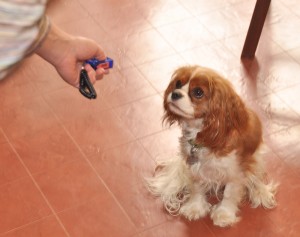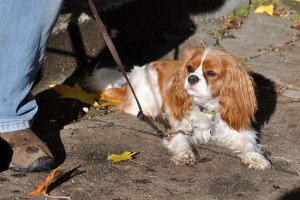[originally posted November 19, 2009]
I was looking for something clever to title this guest post by Mary-Alice Pomputius and then realized I had one of those gems that doesn’t need a flashy setting. This interesting, informative article does exactly what the title says: gives five great training tips to help you travel successfully with your dog. And, in case you haven’t noticed, it includes pictures of one of the cutest dogs in the universe.
Mary-Alice Pomputius and I met on Twitter recently and bonded over our mutual recognition that there were other ways than Cesar’s Way to train dogs — thus her emphasis on using positive techniques to accomplish her goals.
***
Chloe, our 14-month-old Cavalier King Charles Spaniel, is our first dog. When we brought her home, we barely knew that different approaches to dog training existed. Happily, her breeder gave me a copy of The Complete Idiot’s Guide to Positive Dog Training to read on the flight back to Seattle, and our neighbor suggested that I take her to puppy class at Ahimsa Dog Training, so we were on the right path without even realizing it.

As I’ve learned more about the alternatives, I’ve thanked my lucky stars that I thought to ask the breeder and my neighbor for advice. Once Chloe learned that “click” meant “lamb lung,” she’s been a huge fan of training.
Chloe is a terrific traveler — partly because she’s good-tempered enough to accept being zipped into a carrier for hours at a stretch, and partly because she’s learned enough commands to function well in unfamiliar surroundings and among unfamiliar people.
Here are the five commands that we find most useful when traveling:
“Crate” I strongly recommend traveling with a collapsible crate. It provides your dog with a secure den in an unfamiliar room, and it allows you to leave her (if you must) in a comfortable enclosure, where she cannot escape into the hall and beyond during nighttime turn-down and she cannot chew on the furnishings (or the power cords). “Crate” was easy to teach, since every time Chloe went into her crate on command she got showered with treats. The trick was to get her to regard more than one crate as the “crate” of the command, since she has one in our kitchen, one next to our bed, and a couple of different ones that we pack and use for traveling. Spending a little time with each, in each environment, ultimately worked.
“Wait” This command is invaluable at street corners. For us, it means a sit facing forwards in the direction we’re walking (“Let’s go!” releases her to move again with us). Your dog first learns to sit facing you, so the trick was to get her to spin around and face forward instead. Lamb lung bits, held just above nose level, lured her around in a circle until she faced the desired direction, then a “Sit” command got her tush on the ground — click! Once she got the basic idea, the command turned into a counter-clockwise arm swirl and the command “Wait.” This one took some time and patience, but she had it after a couple of weeks of corner-intensive walks.

“This way” We use this to encourage Chloe to move forward and to guide her in the direction we want her to go. It’s a good command for traveling because we often find ourselves on busy sidewalks with her, and it helps steer her around traffic that must be bewildering to a small dog. As she was learning it, she first got a click and a treat for catching my eye and later for moving in the desired direction. A gentle tug on the leash also helps, in combination with some yodeling and capering on your part, but your goal is to catch her attention so the click and the lamb lung can work their magic and get her moving — not to haul her along by force.
“Settle down” This, for us, is a more relaxed, curled-up pose than “Down.” A settled-down Chloe rests at our feet under patio tables while we eat. We owe this one entirely to Ahimsa, which had us bring a small mat to classes, and in between more demanding exercises would have us put the mat down and reward our dog for getting onto it and for any sign of relaxation on it. At home, we’d also use the command and employ the treats whenever she voluntarily curled up on a mat or in a dog bed.

“Sit” I put this one in hesitantly, because what really should be in this position is not a command but a learned behavior — sitting when meeting a new person — and it’s one that Chloe doesn’t really have under her belt yet. We’re working on it, and in the meantime we’ve learned a good stopgap: When your bouncy dog meets a new person, rapidly step on her leash about a foot and a half back from her harness, so that she learns that she will receive pats and attention even though she cannot jump. When Chloe’s traveling, everyone she meets is new, and we think it’s crucial for her to keep “four on the floor.”
Mary-Alice Pomputius writes a dog travel blog called Dog Jaunt, which provides advice for people who want to travel with their small dogs, on trips of any length.

Great tips, thanks for sharing! I’ve found several more good Dog Training Tips
here and an awesome community to share with.
You’re welcome. Looks like you have a log of good information on your blog.